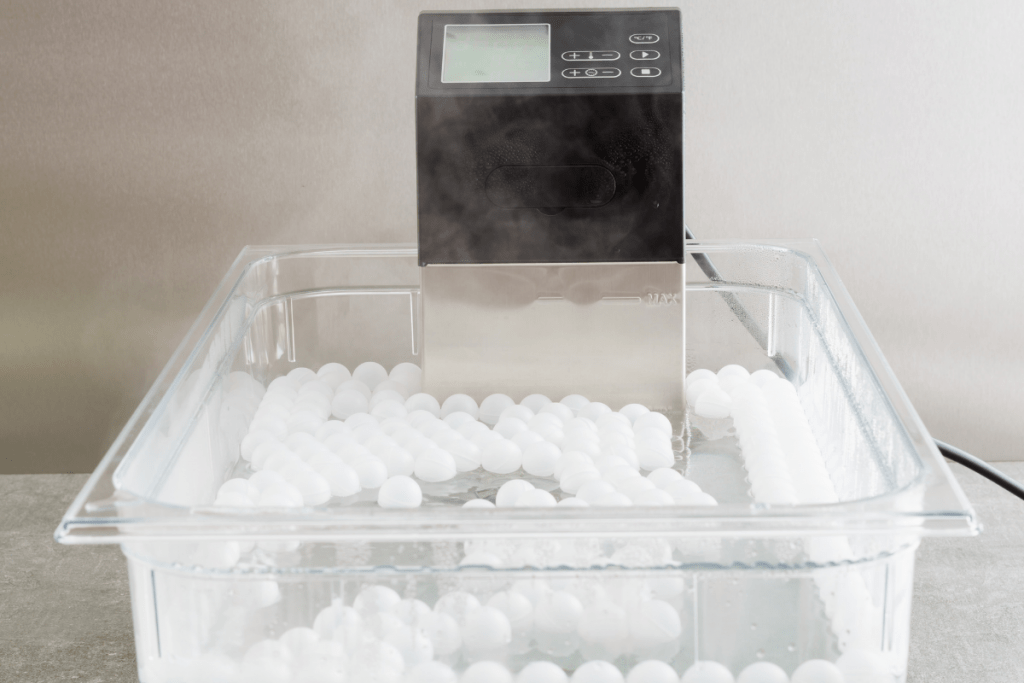Cooking sous vide requires a precision cooker and a plastic bag or vacuum sealer, in addition to all the tools required for more traditional methods.

Types of Sous Vide Heating MachinesTop
Heating your water for sous vide, and maintaining that temperature consistently, is critical for sous vide. There are many different ways you can accomplish this, as well as several different types of sous vide machines. There are many options for heating and controlling the water temperature, ranging from a stove and a thermometer to high end, professional equipment. If you are serious about sous vide and looking for a very high quality, but not too expensive, solution, I highly recommend going with an immersion circulator.
The main types of ways to heat your water, listed in order of precision are: stove top, beer cooler, sous vide temperature controllers, sous vide water baths, and sous vide circulators. The main considerations when picking the type of sous vide machine are price, stability, versatility, and ease of use. Taking these factors into account is the easiest way to narrow down which sous vide machine will be right for you. I have a much more detailed look at the types of sous vide machines and how to pick what is right for you in my sous vide machine breakdown.
The most important part of sous vide cooking is heating the water and keeping it at a consistent temperature and the most reliable way to do that is with a sous vide circulator. A circulator is basically a heating wand that you place into a container of water. It will heat the water to your desired temperature and keep it there indefinitely. Circulators used to be very expensive, running over a thousand dollars, but they have recently dropped in price and good ones can be found for less than $200.
The top brands of sous vide circulators for home kitchens are Anova, Nomiku, and Sansaire, with ChefSteps recently announcing a circulator of their own. For professional kitchens, PolyScience and Grant are the two most popular, both of which have several high quality machines at different prices.
After testing most of the ones available I now use the Sansaire because it is a little quieter than the others (important in a small NY apartment) and heats slightly faster (important when it takes 15 minutes for your facuet to heat up). My Dad has settled on the Anova and that is also what my mother-in-law uses.
We all use them with a Cambro 12 quart container to hold the water. And have cut a lid to prevent evaporation.
Anova, Nomiku, and Sansaire have all released multiple circulators now, but much of our initial sous vide circulator review still holds true. We also have a more detailed review of both the Anova Precision Cooker and the Nomiku circulator.
If you use a sous vide immersion circulator to do your cooking, you will need a container to hold the water. Most large containers will work and people use a variety of things. My top recommendation is to get a polycarbonate container, such as the 12 Quart Cambro or the 12 Quart Rubbermaid. I also have cut a lid to prevent evaporation.
When they are just starting out, many people will just use a stock pot or other large cooking pots. Plastic coolers are also a well-insulated, inexpensive way to hold the water. We have a longer look at the various sous vide containers including their advantages and disadvantages, as well as a look at the lids you can use with the containers.
Sous Vide Searing ToolsTop
Searing your food after it is done cooking sous vide is often a required step if you want flavorful and attractive food. There are many ways to sear your food and what you pick will depend a lot on what you feel most comfortable with.
The most popular ways to sear your foods is in a pan or by using a sous vide torch. I personally have used both methods and I prefer using the BernzOmatic torch. You can read more about torches in our sous vide torch reviews. Many people who sear in a pan highly recommend using a cast iron pan of some sort. You can also finish sous vided food by grilling or smoking. For more searing information, you can check out my comprehensive guide on how to sear sous vide foods.
Before you put your food in the water bath, you need to seal it in something. This is usually a plastic bag of some kind, though mason jars and bottles can work for liquids you are sous viding. A well sealed bag will have all of the air removed and also prevent water from leaking into the bag. There are many ways to seal your food and a lot of it comes down to personal preference. I normally just use Ziploc bags for sous vide because they are inexpensive, always on hand, and easy to use.
At the high end, many people, especially professional kitchens, will use a chambered vacuum sealer to remove all the air. These sealers are also great at preserving and freezing food. Here is our Polyscience 300 Chamber Vacuum Sealer review, a chamber sealer we highly recommend.
A less expensive, home version is the standard FoodSaver-type sealer, though they have several limitations including expensive bags and the inability to seal liquids. You can read more in my guide focusing on the best way to seal food for sous vide.
Equipment Reviews: Sous Vide Machines
FAQ
Do you need a special machine to sous vide?
What is a sous vide machine called?
What are the requirements for sous vide cooking?
